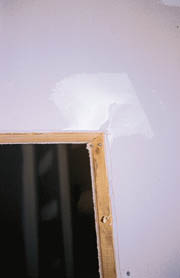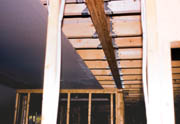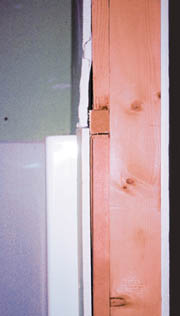

There are times when no matter how particular I am, I just can't get a perfect job. Many times it is because of the things that were done by the trades before me. Nobody likes coming up with excuses and I don't like passing the buck. I would prefer to work together and fix problems before the next step starts.
As I was writing this article, it just kind of hit me that maybe one of the most important things we can all learn is to become aware how something we are doing or not doing is affecting the next phase.
I am a drywall contractor working mostly in residential construction and occasionally some small commercial jobs. I have very few callbacks because I am conscientious and very thorough, and just as important I have weeded out contractors who are not so conscientious and thorough, and I truly believe that is why I don't have many callbacks.
Quite often, problems (other than an over-sanded seam or over-cut outlet) that appear in my drywall work are caused by people working before me. The problems are usually the result of poor framing, settling or poor conditions (poor heat, high humidity, and unconditioned interiors prior to hanging, etc). In addition, sometimes defects in my work are created by subs that come after me.
Also, I like to know what the final decoration will be before I bid the job so I will know how particular I need to be. Maybe the drywall contractor should recommend certain finishes for the best results. It is a good idea to give the information to the general contractor on a regular basis so he is reminded of things like not using glossy paint on a large ceiling or wall for example.
I know it sounds like I am saying that I am perfect and I don't want it to sound that way. A common mistake I make is being in a hurry and not doing a final walk-through after sanding and cleaning. Usually, it is just not paying attention to details but sometimes it is applying the fill coat even though the first coat isn't completely dry. I make these mistakes and then hand the job over to the painter.

Heal thyself
What are we supposed to do? I don't have the time to go over every wall and ceiling with a level and a line before hanging drywall. This is the GC's job and if he is thorough then there are few problems.I have been doing drywall work for 23 years and I believe there are just too many contractors out there who are not paying attention to the details. They still want good results but they are making it difficult.
A drywall job that comes to my mind is a large cathedral ceiling in a church hall that I hung and taped a few years ago. The ceiling and roof was framed with scissor trusses. The trusses were not set on the plates evenly, which not only creates a wavy roof but also a wavy ceiling. The mistake was mostly visible along the center ridge, which was very crooked. I wonder how many people notice this crooked ceiling angle and wonder why the drywall contractor did such a poor job.
When I was talking to my wife about the unshimmed shower walls, wavy ceiling joists, out-of-line jack studs or headers, and out-of-plumb walls, she asked me how contractors are getting away with these mistakes or oversights. I stated that they are usually not terribly noticeable when covered with drywall, taped and painted or are compensated for by scribing in molding or cutting a mitered trim at a different angle or maybe spending a little more time getting a door to fit into an out-of-square opening.
I was hanging drywall around a shower unit and had to do some shimming and back cutting, and I left out a few screws. But when I was finished, I had things looking pretty good. If the owners decide to tile around the shower, then the tile contractor will try to compensate for the slight problems by dividing up the difference and using a little extra mastic. The only people who are aware of the problem are the contractors who lost time and money fudging things in an attempt to correct a problem.
Solutions to problems
Here are some common problems that I see with framing:
• Misaligned studs and headers around doors and windows: Makes drywall difficult to fasten; Jambs are short, which makes it difficult to miter and attach trim.
• Off-level walls: May not be noticeable until window or door is cased or wallpaper is hung.
• Out of-square corners: Difficult to use corner finishing tools when taping; takes more time for trim carpenter to fit trim pieces together.
• Low joist hanger: Creates a bump that often gets worse when settling occurs.
• Unshimmed shower areas: Difficult to attach drywall; creates out-of-plumb walls.
• Low beams: Same as low joist hangers.
• Long walls or ceilings with no breaks: Because of expansion and contraction, this area can result in cracks or ridges in seams.
• Poor Insulation job: A poor insulation job can make drywall difficult to attach. Sagging or popped fasteners, gaps and overstuffed walls are some of the common problems.
• Crooked framing: Often not noticed until drywall is being attached or taped, or trim is being attached.
• Connecting walls or ceilings at different planes: Proper layout of seams will often help with this problem. If not, be prepared for seams that will be difficult to hide.
• Rooms more than 12-feet wide or 16-feet long: Wasteful as far as materials are concerned.
• Gaps in top plates: Could result in excessive settling and cracks, screw pops or ridges.
• Poor conditions such as wet, humid or poor heat: Pre-conditioning is very important. This means having good consistent heat and humidity control. Poor conditions are a major cause of cracking, ridging and fastener pops.
Some problems drywall contractors create or could help eliminate:
• Inside corners built up with too much compound: Can affect the trim carpenter and cabinet installation.
• Outside corners finished too narrow, especially along ceiling or base: May look fine when painted but will affect how well the trim fits the walls.
• Poor seam location: On high walls, seams can be difficult to hide and may crack or ridge over doors or windows, a seam too close to the edges of headers will create problems with mitering casing and the seam may crack.
• Unfilled center of narrow walls: A bowed-in area that is visible along base or cove.
• Chunks of compound along base and edges of doors and windows: Extra work for painter and trim carpenter.
Hanging problems:
• Poor seam location: Seam location is not always considered because it often takes more time to do it right or maybe the hangers are not even aware of problems they are causing.
• Butt seams: Location is important to try to keep out of sight or at least minimize amount.
• Poor fastening: Drywall not tight to wall, may result in pops. Screws too far in result in a weak hold, may pop.
• Too few screws: Could result in pops. Using adhesive is a great idea.
Vertical vs. horizontal:
• Vertical seams are more difficult to hide and often result in excessive lineal footage of seams (as much as 25 percent more).
Drywall left long:
• More work for person installing bead; finish carpenter does not want to have to trim back drywall in order to install window or door jambs.
Finish carpenter problems:
• Wide jambs for pre-hung doors and windows: Out-of-line framing will create extra wide jambs.
• Problem with miters: Seams along miters create bumps; recessed jams are more difficult to fit mitered casing.
• Problems getting base tight to the walls: A common problem caused by poorly feathered out compound, trim has to be caulked and or planed to fit wall.
• Unsquare corners: more difficult to fit trim.
• Wavy wall and inside corners: May not show up until chair rail or cove is installed or a counter top is put into place.

Contractors' thoughts
Frank Caputo, of F. Caputo Construction Co., in Cool, Calif., has seen drywall companies screw on RC channel with shims if necessary to straighten out poorly aligned ceilings. Frank specializes in trim carpentry and states that if he has not worked for a contractor before, he will do a walk-through before drywall work starts. He uses orange spray paint to mark out problems to be corrected. He is looking for problems that will affect his trim work.Rick Arnold, a contractor from Providence, R.I., has an interesting take. He states that before the drywaller starts his phase of the work, he should always make sure things are how you would want them if you were the customer. He mentions that an older tile contractor once told him that once you start working on a floor, you own it. You accept it and you are now responsible for doing what is necessary to create a quality job. I guess the same could be said for a drywall contractor, painter or trim carpenter.
Tom Carty, a contracting framer from Northern California, spends a lot of time making sure the framing details are up to par from checking door openings for size and squareness to opening up the house for the cabinet installer who wants to check walls for straightness and often wants blocking installed for attachment of cabinets.
Donald Fink, of Eastern Oregon Drywall, in Baker City, Ore., is one of the most conscientious drywall contractors I have ever talked to. He does a thorough walk-through, checking not only for framing problems but plumbing and electrical problems that should not be covered. Fink also likes a clean worksite before during and after he does his drywall work. Experience has helped him know what tolerances are acceptable for each contractor he works for.
Gary Katz, a finish carpenter from Reseda, Calif., likes to do an inspection before the drywall work begins. He states it only takes a few hours to walk through a custom home and discover errors and omissions.
I truly believe all the contractors I interviewed, myself included, would agree with Katz when he says, "I do my inspection for free, I don't correct the problems I find for free."
